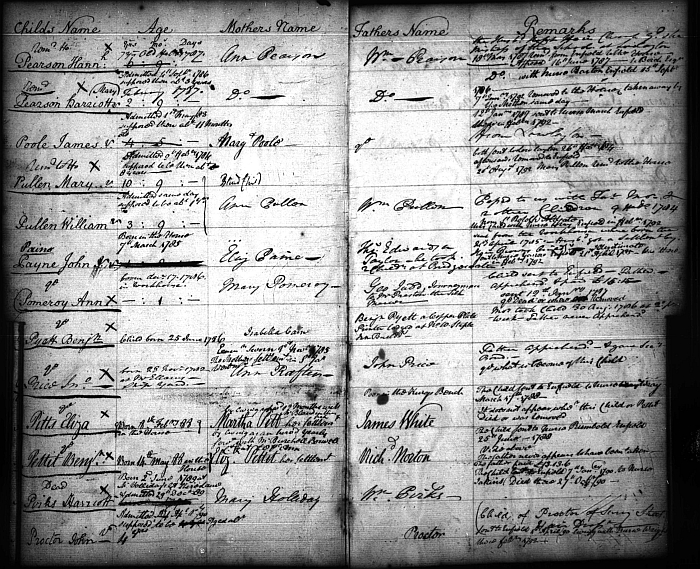Enfield Books: Registers of Parish Children put out to Nurse (BE)
 St Clement Danes, Enfield Book, 1787-98, Westminster Archives Centre, Ms B1261, LL ref: WCCDBE356030043&4.
St Clement Danes, Enfield Book, 1787-98, Westminster Archives Centre, Ms B1261, LL ref: WCCDBE356030043&4.
Introduction
From 1784 the parish of St Clement Danes substantially reformed its care of abandoned and orphaned children, and the Enfield Books, providing details of their names and circumstances, are a product of that reform.
Jonas Hanway and the Reform of St Clement Danes
St Clement Danes was held up to public censure by Jonas Hanway in the 1760s for its alleged poor standards of care for the infant poor, and for the extremely high mortality rate that resulted. The fate of these parish children was used by Hanway in his campaign to enact legislation to ensure that proper registers of the infant poor were maintained,1 and later to require that all parish infants from greater London be nursed in a rural environment at least three miles from the capital.2 Besides simply holding the parish up to the harsh light of publicity Hanway also drew particular attention to the role of parish nurses. He demonstrated that St Clement had one of the worst survival rates for abandoned infants of any London parish, and that while in Westminster as a whole, the infant mortality rate (up to 12 months) for parish children stood at 67 per cent, that for St Clement's was 90 per cent (seventeen dead out of nineteen pauper children born or received into its care under the age of one year).3
It took half a generation for these reforms to really take hold, but from the mid-1780s the parish both created a series of ongoing relationships with a group of nurses located in the Enfield area, north of London, and started to keep a series of more precise and full records.
Apprenticed to Northern Industry
From as early as 1782, the parish began to explore the possibility of apprenticing its parish children to the new factories of the industrial revolution. In June of that year, the vestry decided that "all those above the age of six years to be sent to the silk mills at Watford or elsewhere...". From 1786, the parish entered into a long-term relationship with John Birch and his Backbarrow Mill, at Carmel in Lancashire (now in Cumbria). Between 1786 and 1799, 64 girls and 125 boys were apprenticed by the parish to this mill alone. It was the actions like this by St Clement Danes and other London parishes that led to further controversy and the passage of the first Factory Act in 1802.4
Layout and Content
The Enfield Books are organised as alphabetical tables across two pages of a bound volume, with the child's name in the left hand column, followed a note of his or her date of birth, or when they were admitted to the parish workhouse. This is followed by information about the child's parents and their circumstances, with a final right hand column labelled Remarks. A typical entry, for Catherine and Thomas Trout, records under Remarks that this sister and brother were:
Because this table format does not reproduce well in transcription, it is best to look at the original page images.
Introductory Reading
- Brown, John. A Memoir of Robert Blincoe, An Orphan Boy. Manchester, 1832.
- Hitchcock, Tim. Down and Out in Eighteenth-Century London. 2004, ch. 5.
- Honeyman, Katrina. Child Workers in England, 1780-1820. Aldershot, 2007.
- Innes, Joanna. Origins of the Factory Acts: The Health and Morals of Apprentices Act, 1802. In Landau, N., ed., Law, Crime and English Society, 1660-1830. Cambridge, 2002.
- Taylor, James. Jonas Hanway Founder of the Marine Society: Charity and Policy in Eighteenth-Century Britain. London and Berkeley, 1985.
Online Resources
For further reading on this subject see the London Lives Bibliography.
Documents Included on this Website
- St Clement Danes, Enfield Book, 1787-98, Westminster Archives Centre, Ms. B1261, LL ref: WCCDBE35602, Tagging Level: C
- St Clement Danes, Enfield Book, 1787-98, Westminster Archives Centre, Ms. B1261, LL ref: WCCDBE35603, Tagging Level: C
Back to Top | Introductory Reading
Footnotes
1 2 George III c. 22. ⇑
2 7 George III c. 39. ⇑
3 Jonas Hanway, An Earnest Appeal for Mercy to the Children of the Poor (1766), pp.137-9. ⇑
4 42 George III c. 73. For a detailed account of the parish's activities in this regard see Katrina Honeyman, Child Workers in England, 1780-1820 (Aldershot, 2007). ⇑